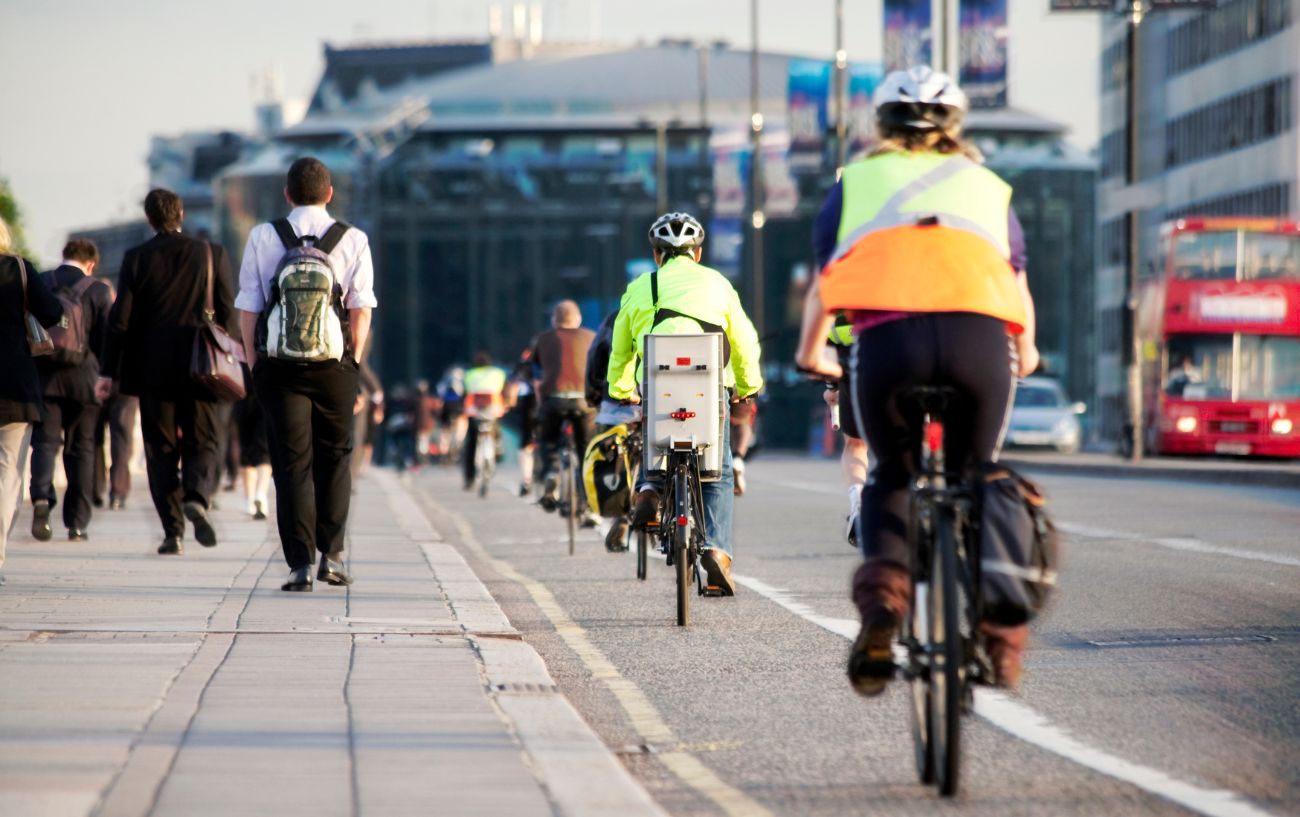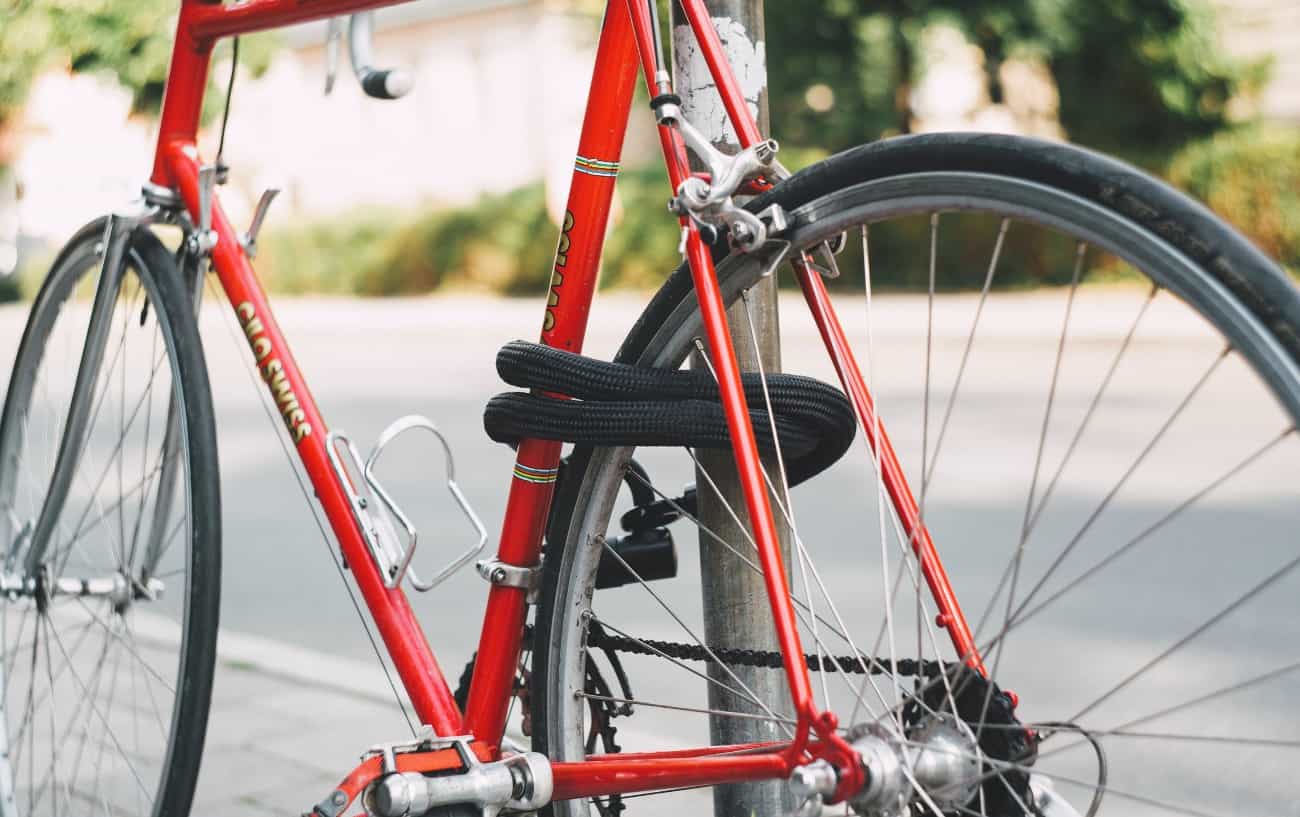Stuffy car rides, packed buses, and noisy trains: if you’re reading this you’re likely considering biking to work.
But commuting by bike is a little more complicated than simply saddling up getting going.
Getting bike commuting right comes with some preparation and good habits, so we’ve prepared a handy list of 14 tips to get you going.
Read on for more detail, and let’s transform your daily commute into a healthy outdoor exercise!

#1. Get the right bike For Commuting
First things first: the bike. Maybe you already have one, but is it right for the job?
If you’re lucky enough to own a carbon fiber Endurance SL, ask yourself if you need to be wheeling out your pride and joy on a work day, even if it does turn a few heads.
Just because you’re likely taking roads to work, your road racing bike might be somewhat excessive for a simple commute.
Remember anything which gets you from A to B relatively pain-free is a good commuting bike.
If you’ve got space for more than one bike at home, consider investing in a “B” team bike to get you to work, and save the big guns for the Saturday morning power hour.
- Buying secondhand is your best bet – check out our guide to valuing a used bike.
If you only have room for one bike in your life then, by all means, ride your trusty bike to work, but pay close attention to later sections on minimizing the risk of theft.
#2. Mudguards Are Your Friends
If your bike doesn’t already have fenders, get some fitted. Honestly, they don’t look so slick, but neither do mud-splattered work clothes.
I’ve spent an embarrassing work day with a grimy streak of puddle water up my back, I don’t recommend it.

#3. Cycle With Proper Lights
It is unsafe (and illegal in many places) to cycle in the dark without front and back bike lights.
You should bring lights every time you leave the house, even if you don’t expect to be riding in the dark.
#4. Dress For The Ride
The right cycling clothes for work is a tricky one and potentially the hardest thing to get right when ironing out a reliable bike-to-work routine.
Now, if you’re lucky and your workplace has showers then you can more or less sidestep this entire issue.
Pack your work clothes (rolled up) in your bag, and bring a plastic bag to store your cycling gear during working hours, ideally in a locker away from your workstation.
If you’re not able to shower at work or don’t want to stress about filling up your bag with towels and spare clothing, then here’s what you want to do:
Start with a waterproof, reflective jacket. Waterproof trousers are also advisable if you’re determined to cycle in on rainy days.
If you opt for regular pants or slacks for the ride, consider buying a pants clip, (even better if reflective.)
Fraying and chain grease-stained pants don’t really say professionalism, so you’ll want to ensure your right hem is safely clear of your drivetrain.
In terms of warmth, I’d recommend deferring to the time-tested mantra: be bold, start cold.
Cycle for more than a few minutes and you’re going to warm up, especially if your commute is hilly.
Turning up to work sweaty and flushed isn’t ideal without that coveted workplace shower, so you’ll want to take steps to avoid this in the wardrobe department.
Barring sub-zero conditions, a single layer under your waterproof or windbreaker is probably fine, grit your teeth as you step out of the house and thank yourself later.

#5. Use A Cycling Bag
You can do yourself a favor by investing in a good bag because turning up to work with a stiff neck and sweaty back will get old quickly.
Go for a reflective, vented rucksack with good support for your shoulders and back, waterproof is even better.
Even better go for a bike with racks for panniers and take the weight off your back altogether, especially if you’re carrying heavy equipment to work such as a laptop.
#6. Don’t Ride Clipless Pedals
This is somewhat contentious and up to the discretion of the commuter, but personally, I don’t like commuting to work wearing cleats.
I prefer clipless pedals and I get frustrated riding without them for training or group rides, but for getting to work and back, I find them more trouble than they’re worth.
Riding clipless pedals to work means packing a change of shoes to avoid clip-clopping around the workplace, and potentially a lot of clipping and unclipping in traffic.
However, if you are riding a bike with clipless pedals to work and you don’t want to be packing spare shoes, or swapping out pedals day to day, you have other options.
Consider platform adapters that clip over clipless pedals to give your shoe a regular pedal platform.
And don’t simply pedal your clipless pedals with regular shoes, the small point of contact under your feet will hurt and you’re much more likely to fall off the pedals, which isn’t safe.
#7. Precycle your route
Ride your commute route at least once before actually riding to work.
This allows you to familiarise yourself with the route stress-free and gives you a rough indication of how long you should expect to take to ride to work.
A few practice rides are also advisable as it gives you space to experiment with a few different routes.
Dedicated cycle paths are always preferable, where available, and you ideally want to minimize traffic lights, merging, and busy or fast roads.
As well as riding around yourself, you can also get a few pointers about popular cycling routes from apps such as Strava or websites like bikemap.net.
#8. Pack The Night Before
I have unfortunately been serially late to work at earlier times in my life, it’s not nice and honestly, it’s easily avoidable.
Pack your bag the night before. Just do it.
Scrambling around to find your cycling gloves during a mad rush out to work isn’t fun.

#9. Leave More Than Enough Time To Get To Work
The second easy thing you can do to ensure you’re not late to work is very simple, give yourself more than enough time.
You need some surplus minutes for getting going once you’re out the door, bad traffic, or the dreaded pre-work roadside repair, plus time to lock up safely and get out of cycling mode.
There’s no set formula but if there was it would probably be something like your cycle time and half as much again.
#10. Practice good traffic Safety
This is the most important point, it might save your life.
Check out our guide to cycling safely in London for a comprehensive walkthrough of safe city riding.
And, as if we need to say it… wear a helmet.
#11. Don’t Listen To Music While You Ride
I get the temptation, I’m a big fan of a good pre-work listening session, but be smarter than that.
Listening to what’s going on around you is one of your vital and necessary tools for maintaining situational awareness whilst riding.
So no tunes, leave yourself open to experiencing your surroundings on your ride to work instead, it’s worth it I promise.
#12. Be Ready For A Roadside Repair
You cross your fingers that it won’t happen but sooner or later you’re going to have bike issues and you may need to make a roadside repair.
So make sure you leave the house packed with a spare innertube, a pump, tire leavers, as a bare minimum. Even better a multitool with a chain tool on it.
And make sure you’re comfortable remounting a dropped chain and changing a flat inner tube.
The alternative is a potentially costly taxi ride to work whilst leaving your bike locked up somewhere unfamiliar for the duration of a working day.

#13. Safely Lock Up Your Bike Whilst At Work
Regrettably, bike theft is very common. You don’t want it to happen to you.
And you don’t want to spend a working day anxiously worrying about the safety of your bike.
Whilst you can never be 100% sure it won’t happen to you, there are simple steps you can take to minimize the risk.
- Lock it up in secure bike storage, ideally, your workplace will have one
- Use a solid U lock, in combination with a security cable to secure the frame and wheels.
- If possible ride an inexpensive bike, (remember what we said about not riding the carbon fiber racing bike to work…)
And remember to remove hardware from the bike after locking up, such as lights and sensors.
#14. Have A Backup Plan
You can’t foresee everything, and you shouldn’t expect to be able to ride to work every day without fail.
Maybe you wake up still sore from a heavy ride the day before, maybe a change to your schedule will mean heading home after dark, which you’d rather avoid, maybe it’s lashing down rain and it just doesn’t feel worth it today…
Choosing to cycle to work is great, having to ride to work is stressful.
Know how you’ll be getting to work in the morning when you change your plans last minute, especially if your ride-in is quicker than your regular commute.
If you follow our tips for biking to work then you’re well set up for a pleasant pre-work ride on whatever days you choose.
So set your alarm, saddle up, and go!



